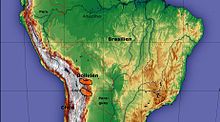Red-eared macaw
| Red-eared macaw | ||||||||||
|---|---|---|---|---|---|---|---|---|---|---|

Red-eared macaw ( Ara rubrogenys ) |
||||||||||
| Systematics | ||||||||||
|
||||||||||
| Scientific name | ||||||||||
| Macaw rubrogenys | ||||||||||
| Lafresnaye , 1847 |
The red-eared macaw ( Ara rubrogenys ) is a species of parrot from the genus of the true macaws ( Ara ) in the family of the true parrots (Psittacidae).
features
The red-eared macaw reaches a body length of 60 cm and a weight of about 500 g. The coloring is predominantly olive green , the rump is olive . The forehead, crown of the head, ear covers and shoulder patch are orange-red, as are the under wing coverts, the flanks and the plumage on the legs. The wings are mostly blue. The tail feathers are olive colored and blue at the top and olive-yellow at the bottom. Compared to other species, the featherless part of the face is quite small and pink-white in color, the iris is orange. The bill and legs are gray-black.
The proportion of red on the head, ear-covers and wings of the young birds is lower. Their coloring is duller with less blue on the inner control springs.
distribution and habitat
The red-eared macaw occurs endemically in a very small range on the eastern slope of the Andes in south-central Bolivia. The habitat of the red-eared macaw is between 1100 and 2500 m, locally up to 3000 m in the inter-Andean dry valleys of Bolivia. In this area there is a steppe and semi-desert climate with thorn bushes, cacti and a few trees.
Way of life
The diet consists of fruits and seeds. Red-eared Macaws also eat crops, especially peanuts and unripe maize, which is why it is locally considered a pest in Bolivia. The sleeping and nesting places are located on undisturbed river cliffs. Oviposition was reported from November and, in exceptional cases, into April. One or two, and occasionally three, young are raised. The parents and young animals remain in the breeding grounds from the end of March to the beginning of April.
Hazard and protection
The red-eared macaw population is very small and continues to decline. The International Union for Conservation of Nature and Natural Resources (IUCN) classifies the species as Endangered (EN). It is listed in the Washington Convention on the Protection of Species (CITES) in Appendix I and in EC Regulation 709/2010 [EC] in Appendix A and is strictly protected according to the Federal Nature Conservation Act [BG] (Status :: s).
Etymology and history of research
Frédéric de Lafresnaye described the red -eared macaw under the name Ara rubro-genys . He had the type specimen from the Muséum national d'histoire naturelle and it came from Bolivia , the place where Alcide Dessalines d'Orbigny had collected it. The word "Ara" comes from an onomatopoeia from the Tupi language for the sounds of the New World parrots . Bernard Germain Lacépède introduced the generic name in 1799. The specific epithet »rubrogenys« is a Latin word formation from »ruber« for »red« and »gena« or Greek »genys, genyos γενυς, γενυος « for »cheek, cheek«.
literature
- Lars Lepperhoff Aras , Ulmer, Stuttgart 2004, ISBN 3-8001-3821-2
- Dieter Hoppe Aras , Ulmer, Stuttgart 1983, ISBN 3-8001-7081-7
- Werner Lantermann Aras Horst Müller-Verlag, Walsrode 1983, ISBN 3-923269-11-0
- James A. Jobling: Helm Dictionary of Scientific Bird Names . Christopher Helm, London 2010, ISBN 978-1-4081-2501-4 .
- Frédéric de Lafresnaye: Quelques oiseaux nouveaux de Bolivie et de Nouvelle-Grenade . In: Revue Zoologique par La Société Cuvierienne . tape 10 , 1847, p. 65-67 ( online [accessed May 6, 2015]).
- Bernard Germain Lacépède: Discours de l'ouverture et de clôture du cours d'Histoire Naturelle donne dans le Museum National d'Histoire Naturelle, l'an VII de la Republique, et Tableaux methodiques des Mammiferes et des Oiseaux . Chez Plassan, Paris 1799.
Individual evidence
- ^ Joseph M. Forshaw, Frank Knigh: Parrots of the World. Princeton University Press, 2010, ISBN 978-0691142852 , p. 180.
- ↑ a b Mike Parr, Tony Juniper: Parrots: A Guide to Parrots of the World. A & C Black, 2003, ISBN 978-0713669336 , p. 146.
- ^ A b Roger G. Sweeney, Michele Earle-Bridges: Macaws. Barrons, 2003, ISBN 978-0764119200 , p. 79.
- ↑ a b Ara rubrogenys in the IUCN Red List of Threatened Species 2011.2. Listed by: BirdLife International, 2008. Retrieved March 9, 2012.
- ↑ Federal Agency for Nature Conservation: WISIA-Online. accessed on November 6, 2011 Search online ( page no longer available , search in web archives ) Info: The link was automatically marked as defective. Please check the link according to the instructions and then remove this notice.
- ↑ Frédéric de Lafresnaye, p. 65.
- ↑ James A. Jobling, p. 52.
- ↑ Bernard Germain Lacépède, p. 1.
- ↑ James A. Jobling, p. 340.
Web links
- Ara rubrogenys inthe IUCN Red List of Threatened Species 2011.2. Listed by: BirdLife International, 2008. Retrieved March 9, 2012.
- Videos, photos and sound recordings of Ara rubrogenys in the Internet Bird Collection
- A. Bennett Hennessey: Protection project for the red-eared macaw in Bolivia
- E. Stumpff: Ara rubrogenys at Animal Diversity Web , 2011
